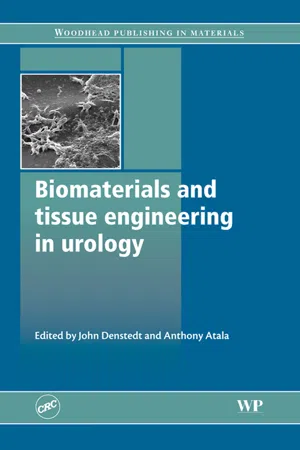
Biomaterials and Tissue Engineering in Urology
John Denstedt,A Atala
- 592 Seiten
- English
- ePUB (handyfreundlich)
- Über iOS und Android verfügbar
Biomaterials and Tissue Engineering in Urology
John Denstedt,A Atala
Über dieses Buch
Urology is the branch of medicine dealing with disorders or diseases of the male genitor-urinary tract and the female urinary tract. This important book summarises the wealth of recent research on the use of biomaterials and tissue engineering to treat urological disorders.Part one reviews the fundamentals with chapters on such topics as biofilms and encrustation formation. Part two then discusses recent advances in biomaterials and design of urological devices such as metal ureteral stents, self-lubricating catheter materials and penile implants. Chapters in Part three address urological tissue engineering with coverage of themes such as artificial and natural biomaterials, nano-technology and placental stem cells for tissue engineering the regeneration of urological tissue and organs.With its eminent editors and international team of contributors, Biomaterials and tissue engineering in urology is an invaluable resource to researchers of urological biomaterials, devices and regenerative medicine in both industry and academia, as well as an important reference for medical practitioners.
- Provides a comprehensive review of biomaterials and tissue engineering in urology
- Explores the fundamentals of urology, focusing on biofilms and encrustation and formation
- Discusses recent advances in biomaterials and the design of urological devices, catheters and stents
Häufig gestellte Fragen
Information
Introduction to biofilms in urology
Abstract
1.1 Introduction
1.2 What are biofilms and why do they form?
1.3 Biofilm formation and structure
Inhaltsverzeichnis
- Cover image
- Title page
- Table of Contents
- Related titles
- Copyright
- Contributor contact details
- Dedication
- Preface
- Part I: Fundamentals
- Part II: Materials and design of urological devices
- Part III: Urological tissue engineering
- Index